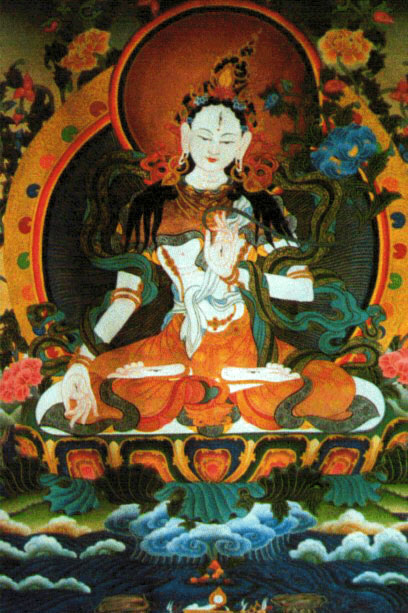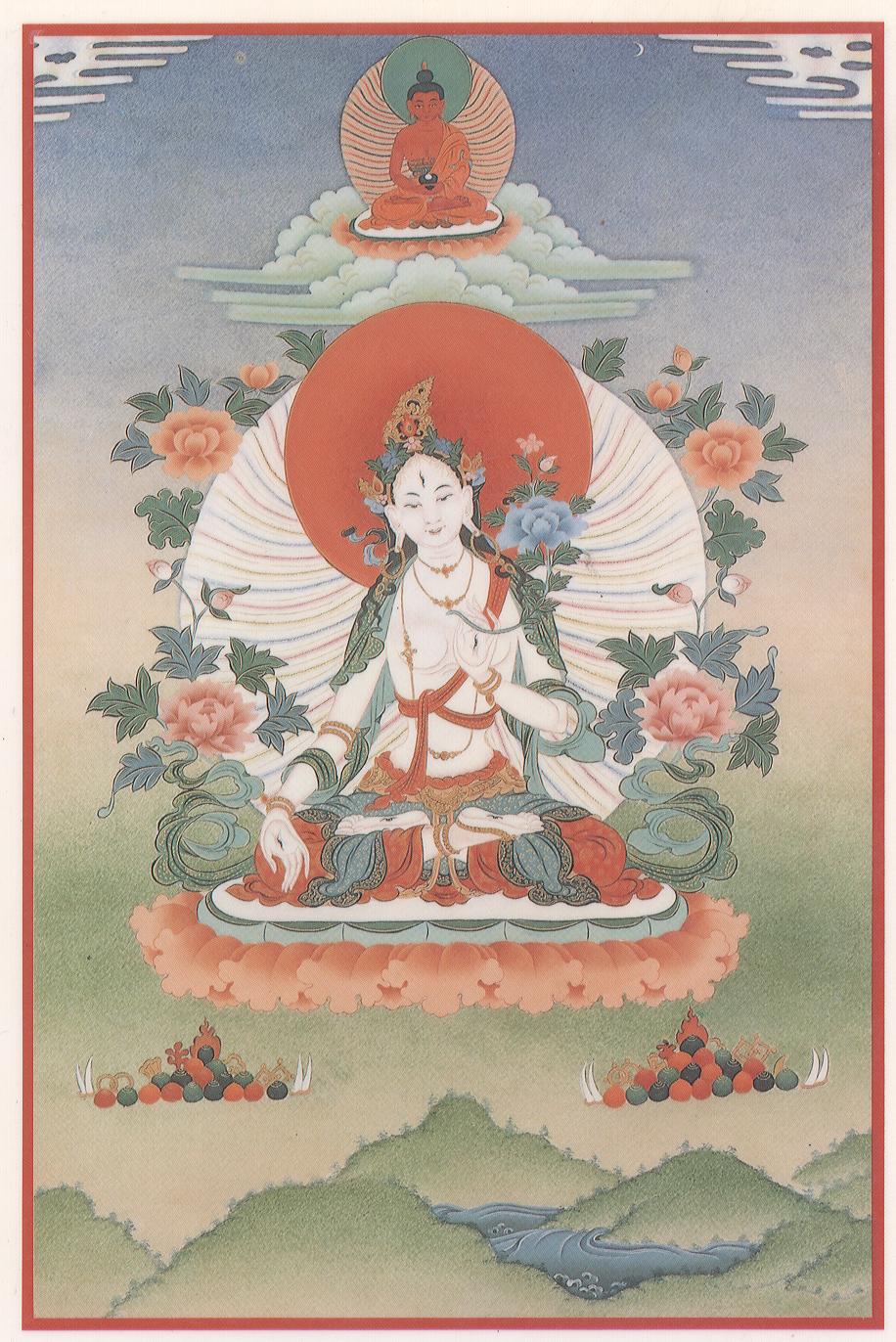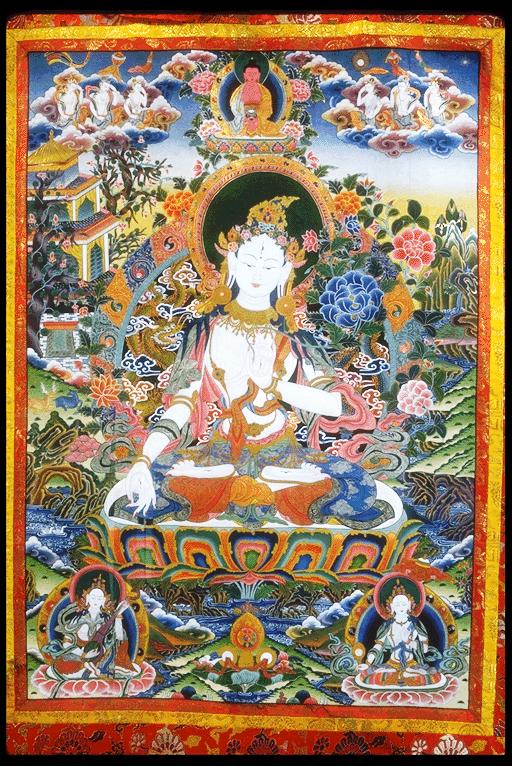| Refuge and
Generating Bodhicitta (three times)
I take refuge until I am
enlightened in the Buddha, the Dharma and the Sangha. By the positive
potential I create by practicing generosity and the other far-reaching
attitudes, may I attain Buddhahood in order to benefit all sentient
beings.
The Four Immeasurable Thoughts
May all sentient beings have
happiness and its causes,
May all sentient beings be free from
suffering and its causes.
May all sentient beings never be separated
from sorrowless bliss.
May all sentient beings abide in equanimity,
free of bias, attachment and anger.
The Seven Limbs
Reverently I prostrate with my
body speech and mind,
And present clouds of every type of offering,
actual and mentally-transformed
I declare all my negative actions
accumulated since beginningless time
And rejoice in the virtues of
all holy and ordinary beings.
Please remain until cyclic existence
ends
And turn the wheel ofDharma for sentient beings
I dedicate
all the virtues of myself and others to the great
enlightenment.
Outer Mandala
This ground, anointed with
perfume, flowers strewn,
Mount Meru, four lands, sun and
moon,
Imagined as a Buddha land and offered to you
May all beings
enjoy this pure land.
Inner Mandala
The objects of attachment,
aversion and ignorance – friends, enemies and
strangers, my body, wealth and enjoyments – I offer these without any
sense of loss. Please accept them with pleasure and inspire me and
others to be free from the three poisonous attitudes.
idam guru ratna mandala kam nirya
tayami
(I send forth this jewelled mandala to
you, precious gurus)
Emptiness meditation
om sobhawa shuddha sarva
dharma sobhawa shuddho ham
(I am the embodiment of the purity of all
subjective and objective phenomena.)
From the sphere of emptiness appears a
white lotus and on it a moon disc. On that appears my own mind in the
form of a white syllable tam which transforms into an utpala
flower marked by tam. This transforms into the self-generated,
life-granting Arya Tara with one face and two arms. Her right hand holds
a utpala flower. In youthful aspect, she is adorned with all the major
and minor marks of a tathagata and is endowed with seven eyes.
Screened by a full moon behind her, her
three places are marked by three syllables om ah hum. From the
seed syllable at her heart, light is emitted, inviting the wisdom beings
and initiating deities.
The wisdom beings merge inseparably with
me; Tara, and the initiating deities confer empowerment. By the overflow
of nectar, my crown is adorned with Amitayus. From the tam at my
heart light is emitted, activating the infinite nectar of longevity from
beyond cyclic existence and dissolving h back into my heart.
Mantra Recitation and
Visualization
From the red hri at Amitayus'
heart, rays of red light shine out into the ten directions, hooking back
the essence of long life from all samsaric and non-samsaric beings and
from the four elements and also hooking back all the life previously
stolen by black magic and so forth. All this is drawn into the nectar in
the long life vase in Amitayus' lap. The nectar increases endlessly and
overflows into my crown and completely fills my body
At my heart, in the tigle on the
white tam, sits my own guru (or anyone whose long life you want
to pray for). Surrounding him on a moon disc, are all sentient beings:
enemies, friends and strangers. Surrounding them, on the edge on the
moon disc, are the letters of the mantra:
om tare tuttare ture mama
ayur punye jnyana pushtim kuru ye soha
The nectar flowing through my body
completely elminates from my guru (or for whomever you are doing this
practice) all hindrances to his/her long life, (which are in fact my own
karmic vision*). The nectar also purifies the hindrances to life and the
black karmic vision of all sentient beings. At the same time, light from
the letters of the mantra fills my own Tara body and the bodies of all
the sentient beings at my heart, especially of those practicing virtue
in the three worlds
*This applies only to the
appearance of sickness in regards to the guru.
While doing this visualization, repeat the
mantra 21 times:
om tare tuttare ture mama
ayur punye jnyana pushtim kuru ye soha
Then as often as you like:
om tare tuttare ture
soha
Think strongly: the hindrances that cause
my guru to appear sick or that prevent his holy wishes from being
fulfilled are all purified. All sentient beings are purified, and all
human beings who are accumulating virtue by just even taking refuge or
by repeating om mani padme hum achieve long life.
Upon seeing the signs of untimely death
instantaneously, by clearly beholding the holy body of the Wish-
Fulfilling Wheel Tara, may I intrepidly conquer the lord of death and
swiftly attain the rank of an immortal master of knowledge.
Dedication of Positive
Potential
Due to this merit may I
soon
Attain the enlightened state of Arya Tara
That I may be
able to liberate
All sentient beings from their suffering.
May the precious bodhi mind
Not yet
born arise and grow;
May that born have no decline,
But increase
forever more.
Translated by Barry Clarke,
with additional meditation
given by the Venerable Lama Thubten Zopa
Rinpoche, 1982
Revised and edited by the Education Department
FPMT
International Office, 1997
Healing
and Self-Healing Through White Tara
by Gehlek
Rimpoche
A fragment from chapter 1: Introduction
Who is Tara?
The being Tara has been worshipped throughout the Buddhist world.
Not only in Tibet, but also in traditional India, China, Japan,
everywhere. Wherever Buddhism has traveled – whether as sutrayana alone
or in combination with tantra – Tara has been worshipped. Even today in
India we find the physical shape of Tara carved in stone or wood
everywhere. She has become so popular that antiques-dealers throughout
the world have those female figures. She may have a slightly different
posture here and there, but that indicates she has been popular. Popular
means commonly accepted. ‘Commonly accepted’ gives you one more
criterion, because when a lot of people accept it, it cannot be wrong.
It cannot be that everybody is wrong.
In Tibet she is called
Drolma, in China Kwan Yin or Kwan Shi Yin. In the Chinese tradition
Avalokiteshvara and Tara are combined together and have become a female
figure. In the Tibetan tradition and in the Sanskrit tradition in India
Avalokiteshvara is seen as a male figure and Tara as a female figure
[both being the embodiment of the compassionate activities of all
buddhas]. In Mongolia and the areas around half the Tibetan and half the
Chinese way is followed; depending on whether it is outer or inner
Mongolia. The Japanese tradition calls her Kannon.
The
Canon-company is named after Tara. They once invited the Dalai Lama to
Japan and took him to their treasury house. The Japanese have so many
strict rules! When they invited the Dalai Lama to the treasury house on
the way a number of vice-presidents had to be dropped at the different
doors. True! At each door the Japanese dropped a vice-president and they
told the Tibetans that one of them must stay behind too. It is said that
when they were inside, the only people that remained among the Japanese
were the president and his executive director, and among the Tibetans
His Holiness and his brother. Then they opened this huge safe and what
was inside was an image of the secret Avalokiteshvara, red, with
consort. And they said, ‘This is Kannon!’ So even in Japan she is very
popular. All the Canon cameras throughout the world are named after her.
Whether or not there is a division between the male,
Avalokiteshvara, and the female, Tara, I think is cultural. One thing
about Buddhism is that it is always adaptable to the different cultures.
Where does this Tara come from? What is she? How does she function?
There are a number of different stories by different masters but the
most reliable and commonly accepted source is The origin of the Tara
tantra written by Taranatha. That says: At first Avalokiteshvara was
very active and busy helping beings. He got almost overwhelmed, worried
to the extend of shedding tears. So he said, ‘I need help’. It is said
in a Hindu-Buddhist mythological story that Avalokiteshvara seeking help
and crying, pinched a tear out and threw it away and suddenly Tara
appeared out of the tear-drop and said, ‘I am here to help you’. It is a
long story, but that is what it boils down to.
It is also told that
Tara is a human being like we are, who has committed:
- to help other beings,
- to help through the physical form of a
female,
- to remain a female throughout.
Why did she choose to remain
female? Because of the importance of the feminine energy and because a
lot of cultures treat females as inferior, as being of lower quality.
That is true throughout the world, like it was true here in the West in
the medieval period.
I remember, the first year I came here late
Hélène van Hoorn took me sightseeing in Holland and we visited a place
where they used to weigh females and give you a certificate ascertaining
that you had a certain weight, thus stating you were not a witch. That
was done in your own country, just a couple of miles from here and a
couple of centuries ago. It is like that in the east, in India, in
China, in Tibet, everywhere. Somehow the world-culture in a certain
period decided that the female body was inferior. Whatever the reason
may be, culture or not, it is there. That is why Tara made the decision
that she would like to remain a female and function as an enlightened
being in female form. Maybe Tara was the first feminist.
So Tara
is very special and particularly very effective. It does not take
millions of years to have effect. The second verse of The praise in
twenty-one homages, a praise to Tara, you find,
‘Homage! Tara, swift, heroic! With regard like instant lightning!’ That
is her quality of quickness, it does not need a million years to be
effective. Therefore it is very special that we can work through
Tara.
There are different physical appearances of Tara; some are
green, some are white, some are yellow, some are red and they carry
different implements. These are what we call manifestations of Tara. One
of the twenty-one manifestations of Tara is called ‘Swift One’. That does not
mean she is the only manifestation that is swift, it means that each
manifestation of Tara manifests a different quality.
These
different manifestations, Wrathful Tara, Powerful Tara, Peaceful Tara,
etc, are all one Tara with different qualities and a different
effect on the individual practitioner. This is why these manifestations
are there. Red Tara, White Tara and Green Tara and so on are not
separate personalities, but at the same time they are not the same
personality either. It is the same Tara, but different aspects of her
quality have taken different physical forms. We call these
nirmanakayas, meaning manifestations and remanifestations and
re-remanifestations.
The word manifestation gives you the meaning
and message of oneness as well as separateness. Take for example the big
rivers. You have big rivers here, right? At some places they go together
and at some places they are separate. When you look at them from a
certain place you can say there are two different rivers – e.g. the Maas
and the Waal – but in some areas you cannot say that this is the Maas
and this is the Waal, because there they are going together. When two
rivers join, like Maas and Waal join at Maasbommel, then from the point
of view of the water you cannot really say: this is water of the Maas
and this is water of the Waal; only when they separate you can identify
them separately and they will function separately. This is a rough
example, but it gives you an idea of a base and its manifestations.
|


